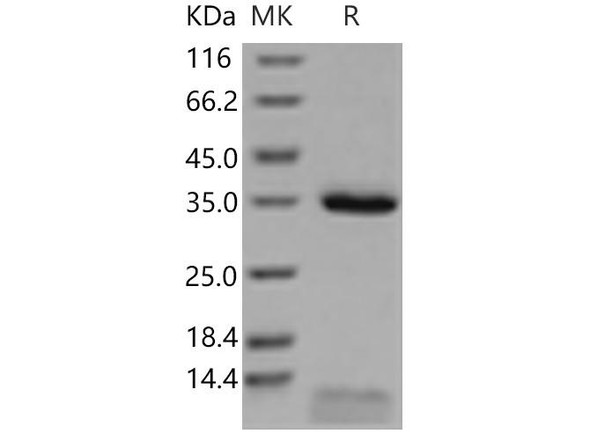Description
| Product Name: | Human B2M Recombinant Recombinant Protein |
| Product Code: | RPPB2842 |
| Size: | 50µg |
| Species: | Human |
| Target: | B2M Recombinant |
| Synonyms: | Beta-2-microglobulin, B2M. |
| Source: | Escherichia Coli |
| Physical Appearance: | Sterile Filtered White lyophilized (freeze-dried) powder. |
| Formulation: | The protein was lyophilized from a concentrated solution (1mg/ml) containing PBS (pH 7.4) and 0.05% NaN3. |
| Solubility: | It is recommended to reconstitute the lyophilized B2M in sterile 18M?-cm H2O not less than 100�g/ml, which can then be further diluted to other aqueous solutions. |
| Stability: | Lyophilized B2M although stable at room temperature for 3 weeks, should be stored desiccated below -18°C. Upon reconstitution B2M should be stored at 4°C between 2-7 days and for future use below -18°C.For long term storage it is recommended to add a carrier protein (0.1% HSA or BSA).Please prevent freeze-thaw cycles. |
| Purity: | Greater than 95.0% as determined by:(a) Analysis by RP-HPLC.(b) Analysis by SDS-PAGE. |
Beta-2 microglobulin is an 11 kDa protein associated with the outer membrane of many cells including lymphocytes. It is the small subunit of the MHC class I molecule. Association with beta 2-microglobulin is generally required for the transport of class I heavy chains from the endoplasmic reticulum to the cell surface. Beta-2 microglobulin associates with class I-like molecules such as CD1 and Qa as well as with the alpha chain of MHC class I molecules. Very limited amounts of MHC class I molecules can be found on the surface in the absence of Beta-2 microglobulin. CD8 T cells cannot develop in the absence of MHC class I.Beta 2-microglobulin is present in small amounts in serum, csf, and urine of normal people, and to a much greater degree in the urine and plasma of patients with tubular proteinaemia, renal failure, or kidney transplants. Human Beta 2 microglobulin levels can rise either because its rate of synthesis has increased (e.g. in AIDS, malignant monoclonal plasma cell dyscrasia, solid tumors and autoimmune disease) or because of impaired renal filtration (e.g. due to renal insufficiency, graft rejection or nephrotoxicity induced by post-transplantation immunosuppressive therapy). Beta-2 microglobulin levels might also be elevated in multiple myeloma and lymphoma cases. Dialysis-related amyloidosis develops after a long-term hemodialysis, it can aggregate into amyloid fibers that deposit in joint spaces.
B2 Microglobulin Human Recombinant produced in E.Coli is a non-glycosylated polypeptide chain having a molecular mass of 11.76 kDa.The B2M is purified by proprietary chromatographic techniques.
| UniProt Protein Function: | B2M: Component of the class I major histocompatibility complex (MHC). Involved in the presentation of peptide antigens to the immune system. Heterodimer of an alpha chain and a beta chain. Beta-2- microglobulin is the beta-chain of major histocompatibility complex class I molecules. Polymers of beta 2-microglobulin can be found in tissues from patients on long-term hemodialysis. Belongs to the beta-2-microglobulin family. |
| UniProt Protein Details: | Protein type:Secreted; Secreted, signal peptide Chromosomal Location of Human Ortholog: 15q21.1 Cellular Component: Golgi membrane; Golgi apparatus; extracellular space; phagocytic vesicle membrane; focal adhesion; membrane; early endosome membrane; endoplasmic reticulum lumen; cytoplasm; plasma membrane; extracellular region; MHC class I protein complex; external side of plasma membrane Molecular Function:identical protein binding; protein binding Biological Process: response to drug; regulation of immune response; viral reproduction; positive regulation of T cell mediated cytotoxicity; antigen processing and presentation of exogenous peptide antigen via MHC class I, TAP-independent; cytokine and chemokine mediated signaling pathway; T cell differentiation in the thymus; antigen processing and presentation of exogenous peptide antigen via MHC class I, TAP-dependent; regulation of defense response to virus by virus; retinal homeostasis; iron ion homeostasis; antigen processing and presentation of peptide antigen via MHC class I; response to cadmium ion; response to molecule of bacterial origin; antigen processing and presentation of exogenous peptide antigen via MHC class I; innate immune response; protein refolding; antigen processing and presentation of exogenous protein antigen via MHC class Ib, TAP-dependent Disease: Hypoproteinemia, Hypercatabolic |
| NCBI Summary: | This gene encodes a serum protein found in association with the major histocompatibility complex (MHC) class I heavy chain on the surface of nearly all nucleated cells. The protein has a predominantly beta-pleated sheet structure that can form amyloid fibrils in some pathological conditions. The encoded antimicrobial protein displays antibacterial activity in amniotic fluid. A mutation in this gene has been shown to result in hypercatabolic hypoproteinemia.[provided by RefSeq, Aug 2014] |
| UniProt Code: | P61769 |
| NCBI GenInfo Identifier: | 48428791 |
| NCBI Gene ID: | 567 |
| NCBI Accession: | P61769.1 |
| UniProt Related Accession: | P61769 |
| Molecular Weight: | |
| NCBI Full Name: | Beta-2-microglobulin |
| NCBI Synonym Full Names: | beta-2-microglobulin |
| NCBI Official Symbol: | B2M�� |
| NCBI Official Synonym Symbols: | IMD43�� |
| NCBI Protein Information: | beta-2-microglobulin |
| UniProt Protein Name: | Beta-2-microglobulin |
| Protein Family: | Beta-2-microglobulin |
| UniProt Gene Name: | B2M�� |
| UniProt Entry Name: | B2MG_HUMAN |









